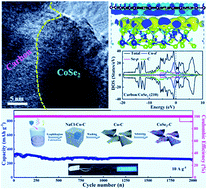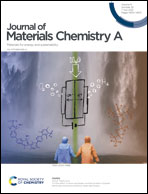In situ construction of active interfaces towards improved high-rate performance of CoSe2†
Abstract
Transition metal selenides as anode materials hold great promise in obtaining outstanding sodium-ion batteries. However, the dramatic volume change of transition metal selenides causing poor rate capacity and inferior cycling performance limits their practical application in sodium ion batteries. In this work, a confined-regulated interfacial engineering strategy for the growth of cobalt selenide nanosheets on ultrathin carbon flakes is reported (denoted as CoSe2-CNS). The strong interfacial interaction between CoSe2 and carbon flakes endows CoSe2-CNS with fast electron/sodium ion transport kinetics and good structural stability, thus delivering superior rate capability (352 mA h g−1 at 10 A g−1) and excellent cycling durability. Furthermore, various ex situ characterization techniques and first-principles calculations have been used to unravel the sodium ion storage mechanism of CoSe2-CNS. Impressively, the CoSe2-CNS//NVPOF full cell, which is assembled by combining the CoSe2-CNS anode with a Na3V2(PO4)2O2F (denoted as NVPOF) cathode, exhibits a high capacity of ∼275 mA h g−1 at 0.1 A g−1. Moreover, the assembled full sodium-ion battery possesses the maximum energy density of 115 W h kg−1 and a peak power density of 9214 W kg−1, making CoSe2-CNS a promising anode material for high-performance sodium-ion batteries.



 Please wait while we load your content...
Please wait while we load your content...